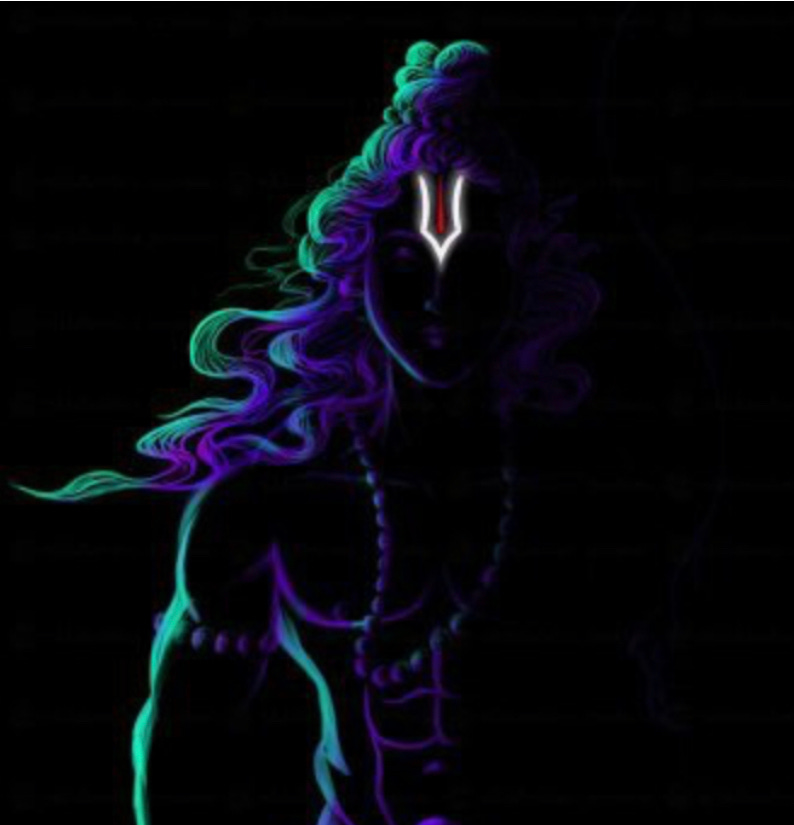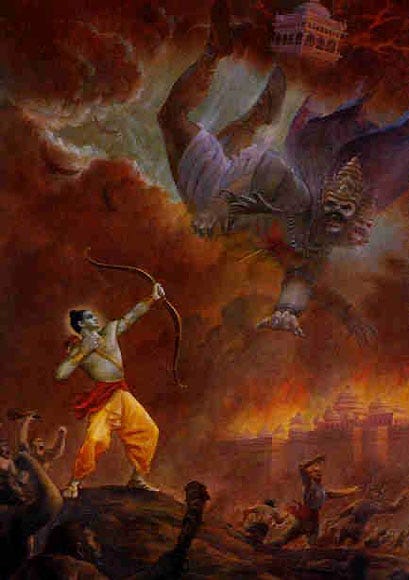Writing on this substack over the past year has been a great experience; it’s connected me with some very thoughtful people, and it’s pushed me to properly dig into material that had been in my reading backlog for years. Admittedly, it’s also been a bit inconsistent; my ability to cover an entire book or philosopher in a single post was starting to hit some practical limits (I’m looking at you, Wittgenstein). My intention moving forward is to publish more frequent, digestible posts - which are focused on narrower portions of religious and philosophical texts, or specific themes. I can’t think of a better place to start than with the opening chapter of the story that’s often considered the bedrock of Indian mythology: The Ramayana.
The Ramayana is THE story - the epic saga - of God as king. Lord Vishnu, The Supreme Preserver within the Hindu Trinity, incarnates as Rama - the protagonist and ultimate hero of the story. In all of its intricacies, subplots, and details - the Story of Rama - from his birth through to his adventures, his compatriots, and his enemies - is meant to reveal capital-T truths about the nature of duty, or dharma - as it relates to our individual conduct, interpersonal responsibilities, and the confrontation of unworthy modes of being. It also contains many dialogues that discuss the theorized structure of reality itself; the world, the cosmos, and everything throughout.
Every story, however epic, has a starting point. When I’d read the “abridged” version of the Ramayana as a teenager, the story was presented in prosaic fashion: in about 200 pages, the entire expanse of the six-volume epic was covered - concisely, and with uniform pacing. It wasn’t until I examined the full verse-by-verse rendition of the epic that I realized just how much context and texture was simply missing from those condensed versions. In fact, if you’re looking for a condensed version: the very first chapter of the full-form Ramayana is a synopsis of the entire story…!
The Most Virtuous Man
The first verses open with Valmiki, the author of the epic-to-be-told, speaking with the legendary sage, Narada. (Narada is famous for appearing within all sorts of stories across Indian mythology, often serving as the catalyst for a new adventure or a plot twist.) In effect, Valmiki is asking Narada: who is the greatest of them all?
“Who really is that person in this present world, who is virtuous and vigorous, a conscientious one, one who is mindful of good deeds done to him, and also a speaker of truth and who is determined in his deed…”
“Who is appropriate in disposition... who is interested in welfare of all beings... who is adept and also an able one... also uniquely pleasant to look at…”
“Who is that self-composed one, who controlled his ire, who is brilliant, non-jealous and whom do even the gods fear, when provoked to war...”
Narada provides a very matter-of-fact reply: the most virtuous man is Rama, the then-present king of the Ikshvaku dynasty, and ruler of the Kingdom of Ayodhya. Narada then proceeds to elaborate, describing the myriad dimensions of Rama’s unparalleled excellence:
…
“He is a wise one, moralist, eloquent, glorious, and a destroyer of enemies. His arms are lengthy, with three lines in the neck [indicative of good fortune], and cheekbones high...”“He is lion-chested, with concealed collarbones, knee-length are his arms, and his is a long bow, an enemy-subjugator, and his emperor's countenance is with a crowning-head and an ample forehead, and his gait is majestic like that of a lion...”
“He is the knower of rectitude, bidden by the truth, also his concern is in the welfare of subjects, proficient in prudence, clean in his conduct, self-controlled and an attentive one...”
“He is the knower of the meaning and essence of all the scriptures, excellent at memory, a brilliant one, and dear to all the worlds, gentle, level-headed and clear-headed in discriminating and distinguishing...”
…
Interestingly, here Narada alludes to the fact that Rama’s greatness transcends the normative spheres of human experience: the reference to him being “dear to all worlds” in Sanskrit is sarvalokapriyaH - a literal reference to the celestial dimensions of reality that house the gods and other metaphysical forces. Throughout his response, however, it’s ambiguous as to whether Narada is letting Valmiki know that Rama is the literal incarnation of Vishnu. From what I’ve gathered, many believe it is left intentionally vague; Rama is replete with qualities that place him beyond any normal man, and Narada wants to call attention to his unique stature (and not preemptively frame him as simply another divine incarnation).
The Synopsis
In the second half of the opening chapter, Narada then proceeds to tell the full story of the Ramayana to Valmiki. The meta-textual element here is, of course, that Valmiki is the author of the epic; and so here he’s recalling (in summarized form) the first time he heard the story. Narada begins by describing the intentions that Rama’s father, King Dasaratha, had to make his eminently virtuous son the next king. Rama is eldest of four brothers, collectively born to three different royal consorts.
Rama’s selection as crown-prince greatly upsets Kaikeyi, the mother of his half-brother Bharata (who she believes should instead be the future king). In this initial summary, it isn’t elaborated how exactly Kaikeyi engineers the scheme to exile Rama - but there is reference to “divine boons” that were granted to her by the king. While the intractability of the situation torments King Dasaratha, Rama himself is presented as unflinching; he holds no ill-will towards Kaikeyi (effectively another mother to him), and he forthrightly proceeds into exile for 14 years.
Rama is accompanied by his wife, Sita (who Narada describes as “a divine marvel, equal to the life of Rama”); and by the closest and most capable of his brothers, Lakshmana. The royal court and the wider citizenry walk with the trio up till the edge of the kingdom (known as Ayodhya), heartbroken that the should-be future king must now proceed into exile - and the wider unknown.
The heart of the story then unfolds in earnest, with Rama, Sita, and Lakshmana traversing through the great wilds of India. A while after Rama’s departure, King Dasaratha dies from existential grief. Bharata, the replacement crown-prince, treks out to find Rama and convince him to ignore his own mother’s pact, and to come home to serve as king. Rama refuses, stating that he will fulfill his agreed-upon term in exile. Bharata, ever steadfast and loyal to his brother, returns with Rama’s sandals - and insists on placing them upon the throne until the true king returns.
The adventures throughout the wilds lead to a plethora of subplots, involving entities that range from the routine to the supernatural. Eventually the divine trio encounters truly demonic forces, which they must engage. This escalates into a conflict with Ravana, the demon-king and central antagonist of the epic. Ravana ends up orchestrating the kidnapping of Sita, which draws the story into its climactic arc. Rama and Lakshmana set out to rescue the queen-in-exile, assembling a veritable army along the way.
The saga of Rama building his army could fill volumes by itself; he bands together a diverse mix of people, animals, supernatural creatures, and celestial forces into a coalition capable of taking on Ravana. The tales from this part of the epic are particularly memorable, introducing figures like Hanuman, whose theological placement in Hinduism remains inextricably linked to Rama. The divine army eventually crosses into Lanka, the home of Ravana.
Rama, at the climax of the final battle, confronts and eradicates Ravana. He then reunites with Sita, and validates that she has indeed remained faithful during her imprisonment. This “testing of Sita” is among the most complex and debated portions of the Ramayana; the next few chapters will show how prominently Sita’s tribulations play into the framing of the wider epic.
Narada concludes by describing Rama’s return to the Kingdom of Ayodhya, having won the supreme victory for his realm and all others. Narada tells Valmiki that Rama is destined to fulfill a 11,000 year reign upon the throne - which will preside over unparalleled flourishing, and through his descendants will seed hundreds of new kingly dynasties. Upon the completion of his singular dharma (divine duty), Rama will then ascend to the highest of heavenly planes, Brahmaloka.
All of these events are said to have happened thousands of years ago, in a prior phase (yuga) of the Hindu cosmic cycle. The chronology around Rama’s reign is another thoroughly debated topic, which I’m looking forward to examining at some point down the road.
Onward
With Narada’s telling (which we can assume was transmitted with full fidelity, and simply abridged in this opening chapter), Valmiki now carries the story of The Ramayana with him. As we’ll see in the next chapter, there is still a bit more meta-commentary, as Valmiki explains what actually prompted him to translate Narada’s poem into written form. See you next time…








